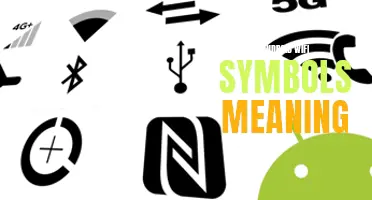
The Chi Rho symbol is one of the oldest and most recognizable symbols in Christianity, representing the Greek letters that spell out the name of Christ. Its origins can be traced back to the early days of the faith, and its meaning has evolved over time to symbolize the power and victory of Christ over sin and death. Today, the Chi Rho symbol continues to hold great significance for Christians around the world, serving as a reminder of the central figure of their faith and the hope and salvation he offers.
What You'll Learn
- What is the origin and history of the Chi Rho symbol?
- How is the Chi Rho symbol used in Christianity?
- What is the symbolism behind the intertwining of the Greek letters Chi and Rho in the symbol?
- How does the Chi Rho symbol relate to the early Christian persecution and its subsequent rise as a symbol of victory?
- Are there any variations or adaptations of the Chi Rho symbol in different cultures or religions?

What is the origin and history of the Chi Rho symbol?
The Chi Rho symbol is one of the most recognizable symbols in Christianity, representing the first two letters of the Greek word for Christ. It consists of intersecting the capital Greek letters Chi (Χ) and Rho (Ρ), forming an X-shaped symbol. But what is the origin and history of this ancient symbol?
The Chi Rho symbol has its roots in the ancient Greek language and was primarily used as a symbol for the Greek god Apollo. However, its association with Christianity stems from a vision that the Roman Emperor Constantine the Great had before the Battle of Milvian Bridge in 312 AD.
According to historical accounts, Constantine saw a vision of a Chi Rho symbol in the sky along with the words "In hoc signo vinces," which means "In this sign, you will conquer." Inspired by this vision, Constantine ordered his soldiers to paint the Chi Rho symbol on their shields, and they emerged victorious in the battle.
Following his victory, Constantine issued the Edict of Milan in 313 AD, which granted religious tolerance to Christians in the Roman Empire. This marked a significant turning point for Christianity, as it went from being a persecuted religion to being the favored religion of the empire.
As a result of Constantine's influence, the Chi Rho symbol became closely associated with Christianity. It began appearing in Christian art and on various religious objects, such as jewelry and manuscripts. The symbol served as a visual representation of Christ and his victory over sin and death.
Over time, different variations and interpretations of the Chi Rho symbol emerged. Some featured additional symbols, such as the alpha and omega, representing the beginning and the end, or a cross, representing Christ's crucifixion. These variations allowed for more intricate and symbolic depictions of the Chi Rho symbol in Christian art.
The Chi Rho symbol continued to be prominent in Christianity throughout the Middle Ages and beyond. It appeared in illuminated manuscripts, church decorations, and even on the coins of various Christian rulers. Today, it remains a widely recognized symbol of Christianity and is often seen in churches, religious artifacts, and Christian-themed artwork.
In conclusion, the Chi Rho symbol has a rich history that dates back to ancient Greece but became closely associated with Christianity through the vision of Emperor Constantine. Its use as a symbol for Christ and his victory has made it a significant and enduring symbol in Christian art and culture.
Unraveling the Mysteries: Exploring the Symbols and Meanings of Love
You may want to see also

How is the Chi Rho symbol used in Christianity?
The Chi Rho symbol is one of the oldest and most widely recognized symbols used in Christianity. Its origins can be traced back to the early days of the faith when it was utilized as a secret symbol for Christians to identify themselves to one another.
The Chi Rho is formed by overlapping the first two letters (X and P) of the Greek word for Christ, which is ΧΡΙΣΤΟΣ. The resulting symbol resembles a monogram of the name Christ and has been used as a shorthand representation of Jesus throughout the centuries.
One of the earliest known uses of the Chi Rho symbol can be found in the Catacombs of Rome, a network of underground burial places where early Christians gathered to worship and bury their dead. The symbol was often carved or painted on the walls of these catacombs, serving as a reminder of the hope of resurrection and eternal life in Christ.
The Chi Rho symbol gained even greater prominence in the fourth century when the Roman Emperor Constantine the Great saw the symbol in a dream or vision before a crucial battle. According to the story, Constantine heard a voice saying, "By this sign, conquer." He subsequently ordered his soldiers to paint the Chi Rho symbol on their shields, and they emerged victorious in battle. This event is often referred to as the "Miracle of the Chi Rho" and is seen as a turning point in the relationship between Christianity and the Roman Empire.
Following Constantine's conversion to Christianity, the Chi Rho symbol became widely associated with the Christian faith and was used in a variety of ways. It appeared on coins, banners, and flags, as well as in the decoration of churches and other Christian buildings. The symbol became a powerful visual representation of the triumph of Christianity and the spread of the gospel.
In addition to its use as a general Christian symbol, the Chi Rho has also been incorporated into specific Christian sacraments and rituals. For example, it is often seen in the decoration of baptismal fonts, where believers enter into the death and resurrection of Christ. Similarly, it is sometimes used as an emblem of the Eucharist, representing the body and blood of Christ.
Today, the Chi Rho symbol continues to be used by Christians of various denominations as a sign of their faith. It can be found in churches, on religious artwork, and as jewelry worn by believers. The symbol serves as a reminder of the central message of Christianity – the life, death, and resurrection of Jesus Christ – and the hope that it brings.
In conclusion, the Chi Rho symbol holds significant meaning in Christianity. From its early use as a secret symbol among early Christians to its association with the conversion of Constantine and the spread of Christianity, the Chi Rho has become an enduring and recognizable symbol of the faith. Whether used in worship, sacraments, or as a personal reminder of one's belief, the Chi Rho continues to be a powerful symbol that represents the core teachings of Christianity.
Exploring the Rich Symbolism of Ghana: Unveiling the Hidden Meanings of Ghanaian Symbols
You may want to see also

What is the symbolism behind the intertwining of the Greek letters Chi and Rho in the symbol?
The intertwining of the Greek letters Chi and Rho in the symbol, also known as the Chi-Rho symbol, holds significant symbolism in Christianity. Derived from the first two letters of the Greek word "Christos," meaning Christ, this symbol has a rich history and represents the essence of the Christian faith.
The Chi-Rho symbol is formed by superimposing the capital letters Chi (X) and Rho (P) from the Greek alphabet. The Chi letter is represented by an "X" shape, while the Rho letter looks like a "P" with a curved tail. When these two letters are combined, they form the distinctive Chi-Rho symbol.
The history of this symbol dates back to the 4th century AD during the time of Emperor Constantine the Great, who played a crucial role in the legalization of Christianity in the Roman Empire. According to legend, Constantine had a vision before a decisive battle at the Milvian Bridge in 312 AD. He saw the Chi-Rho symbol in the sky accompanied by the words "in hoc signo vinces" (in this sign, you will conquer). Taking this as a divine sign, Constantine used the Chi-Rho symbol on his banners and emblems, leading to his victory. This event is often credited with his conversion to Christianity and the subsequent rise of the religion.
The intertwining of the Chi and Rho letters in the symbol represents the inseparable union of Christ's divinity and humanity. The Chi symbolizes the first letter of the Greek word Christos, representing Jesus as the anointed one, the Messiah. The Rho symbolizes the second letter of the Greek word, emphasizing Jesus' role as the Savior. In Christianity, Jesus is believed to be the Son of God who took on human form to save humanity from sin and provide redemption.
Beyond the initial representation of Christ's divinity and humanity, the Chi-Rho symbol holds various other meanings. It serves as a powerful reminder of the crucifixion and resurrection of Jesus, as the lines of the Chi resemble the shape of a cross. Additionally, it signifies victory over death and eternal life through faith in Christ. The symbol also serves as a visible proclamation of Christianity, acting as a badge of identification for believers.
The Chi-Rho symbol has remained prominent in Christian art, architecture, and religious artifacts throughout history. It can be found on early Christian sarcophagi, frescoes, mosaics, and medieval manuscripts. It is often displayed in churches, on religious banners, and as jewelry or tattoos among Christians as a symbol of their faith and devotion.
In conclusion, the intertwining of the Greek letters Chi and Rho in the Chi-Rho symbol holds deep symbolism in Christianity. It represents the inseparable union of Christ's divinity and humanity, his role as the Savior, and the victory over death. The symbol has a rich history and serves as a powerful reminder of the central beliefs of the Christian faith.
The Intriguing Meanings Behind LPS Eye Symbols Explained
You may want to see also

How does the Chi Rho symbol relate to the early Christian persecution and its subsequent rise as a symbol of victory?
The Chi Rho symbol, one of the earliest Christological symbols, has a fascinating history that is deeply linked to the early Christian persecution and its subsequent rise as a symbol of victory. This powerful emblem, formed by the superimposition of the Greek letters "chi" (Χ) and "rho" (Ρ), represents the first two letters of the word "Christ" in Greek (ΧΡΙΣΤΟΣ).
During the early years of Christianity, believers faced severe persecution from the Roman Empire. Emperor Nero, for example, blamed Christians for the Great Fire of Rome in 64 AD, leading to the first major wave of persecution. Christians were imprisoned, tortured, and even executed for their faith. However, amidst these difficult times, the early Christians found solace and hope in their faith, and the Chi Rho symbol served as a secret, mutual identifier for them.
The symbol's origins can be traced back to the vision of the Roman Emperor Constantine the Great. Before the Battle of Milvian Bridge in 312 AD, Constantine allegedly had a vision of the Chi Rho symbol with the words "In hoc signo vinces" ("In this sign, you will conquer") written beneath it. Inspired by this vision, Constantine had the symbol painted on his soldiers' shields, and they achieved a decisive victory in the battle.
This victory marked a turning point in the history of Christianity. Constantine, who went on to become the first Christian Emperor of Rome, issued the Edict of Milan in 313 AD, which granted religious tolerance to Christians. This marked the end of the era of persecutions and the beginning of Christianity's rise to prominence in the Roman Empire. The Chi Rho symbol, associated with Constantine's victory, became widely recognized and embraced by Christians as a symbol of divine protection and triumph.
In the subsequent years, the Chi Rho symbol became a ubiquitous motif in Christian art and architecture. It adorned frescoes, mosaics, and even sarcophagi, serving as a reminder of Christ's victory over death and the ultimate victory of Christianity over its persecutors. The symbol's popularity continued to grow, and it remains a significant symbol in Christian iconography to this day.
The Chi Rho symbol also holds a rich theological meaning. The combination of the Greek letters "chi" and "rho" not only represents the name of Christ but also symbolizes his dual nature as both fully divine (represented by the "rho") and fully human (represented by the "chi"). This duality was a central theological concept during the early Christian era and continues to be a fundamental belief in Christianity.
In conclusion, the Chi Rho symbol's relationship with the early Christian persecution and its subsequent rise as a symbol of victory is a testament to the resilience and faith of the early Christians. From its humble beginnings as a secret identifier during times of persecution, the symbol gained divine significance through Constantine's victory and became a prominent emblem of Christ's triumph over adversity. Today, the Chi Rho symbol serves as a powerful reminder of Christianity's enduring endurance and hope in the face of challenges.
Understanding the Symbol Meanings on Power XL Air Fryers
You may want to see also

Are there any variations or adaptations of the Chi Rho symbol in different cultures or religions?
The Chi Rho symbol is a prominent symbol in Christianity, representing the first two letters of the Greek word for Christ (ΧΡΙΣΤΟΣ). It is widely recognized in Western Christianity as a symbol of Christ and his followers. However, variations and adaptations of the Chi Rho symbol can be found in different cultures and religions.
In Christian symbolism, the Chi Rho has a long history and is often associated with the Emperor Constantine, who converted to Christianity in the 4th century. According to legend, Constantine saw a vision of the Chi Rho symbol in the sky before a crucial battle, and he subsequently adopted it as a symbol of his faith. The Chi Rho became a popular Christian symbol in the Byzantine Empire and has continued to be used in various forms throughout Christian history.
Outside of Christianity, the Chi Rho symbol has been adopted and adapted by different cultures and religions. In ancient Egyptian religion, the Ankh symbol, which resembles the Chi Rho, represents eternal life and immortality. It has been suggested that early Christians in Egypt may have incorporated elements of the Ankh symbol into the Chi Rho.
In Norse mythology, the Thor's hammer, also known as Mjolnir, bears a resemblance to the Chi Rho. The hammer is a symbol of the god Thor and is associated with protection and strength. Some scholars believe that the Chi Rho symbol may have influenced the design of Thor's hammer in Norse mythology.
In addition, variations of the Chi Rho symbol can be found in non-Christian contexts. For example, in the ancient Indian symbol known as the Surya Namskar, the Chi Rho is combined with the Swastika symbol to represent the sun and its life-giving properties. The Chi Rho is also incorporated into various esoteric and occult traditions, where it is often associated with spiritual transformation and enlightenment.
In conclusion, while the Chi Rho symbol has its roots in Christianity, it has been adopted and adapted by various cultures and religions throughout history. Variations of the Chi Rho can be found in different contexts, from ancient Egyptian and Norse mythology to non-Christian spiritual traditions. These adaptations and variations highlight the enduring power and significance of the Chi Rho symbol across cultures and religions.
The Symbolic Meaning Behind Goats: What Do They Represent?
You may want to see also
Frequently asked questions
The Chi Rho symbol is an ancient Christian symbol that combines the first two letters of the Greek word for Christ, "Chi" (χ), and "Rho" (ρ). It is a monogram that represents Jesus Christ and is often used as a symbol of Christianity.
The Chi Rho symbol became important in Christianity because it was one of the first symbols used to represent Jesus Christ. It dates back to the time of the early Christians and was often used as a secret symbol to identify fellow believers. The symbol is a powerful reminder of the central figure of the Christian faith and is still recognized and used today.
There are several variations of the Chi Rho symbol, each with their own unique design elements. Some variations incorporate additional symbols or imagery, such as a cross, a crown, or an anchor, to further emphasize the Christian significance. These variations can be found in religious art, jewelry, and other forms of Christian symbolism.







